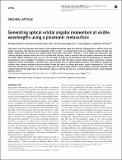Files in this item
Generating optical orbital angular momentum at visible wavelengths using a plasmonic metasurface
Item metadata
| dc.contributor.author | Karimi, Ebrahim | |
| dc.contributor.author | Schulz, Sebastian A | |
| dc.contributor.author | De Leon, Israel | |
| dc.contributor.author | Qassim, Hammam | |
| dc.contributor.author | Upham, Jeremy | |
| dc.contributor.author | Boyd, Robert W | |
| dc.date.accessioned | 2018-03-20T15:30:09Z | |
| dc.date.available | 2018-03-20T15:30:09Z | |
| dc.date.issued | 2014-05-09 | |
| dc.identifier | 252585128 | |
| dc.identifier | bb744bed-673f-48a0-b6ff-74833ba374af | |
| dc.identifier | 84901438834 | |
| dc.identifier.citation | Karimi , E , Schulz , S A , De Leon , I , Qassim , H , Upham , J & Boyd , R W 2014 , ' Generating optical orbital angular momentum at visible wavelengths using a plasmonic metasurface ' , Light: Science & Applications , vol. 3 , e167 , pp. 1-4 . https://doi.org/10.1038/lsa.2014.48 | en |
| dc.identifier.issn | 2047-7538 | |
| dc.identifier.other | crossref: 10.1038/lsa.2014.48 | |
| dc.identifier.other | ORCID: /0000-0001-5169-0337/work/46569143 | |
| dc.identifier.uri | https://hdl.handle.net/10023/12980 | |
| dc.description | The authors acknowledge the support of the Canada Excellence Research Chairs Program. | en |
| dc.description.abstract | Light beams with a helical phase-front possess orbital angular momentum along their direction of propagation in addition to the spin angular momentum that describes their polarisation. Until recently, it was thought that these two ‘rotational’ motions of light were largely independent and could not be coupled during light–matter interactions. However, it is now known that interactions with carefully designed complex media can result in spin-to-orbit coupling, where a change of the spin angular momentum will modify the orbital angular momentum and vice versa. In this work, we propose and demonstrate that the birefringence of plasmonic nanostructures can be wielded to transform circularly polarised light into light carrying orbital angular momentum. A device operating at visible wavelengths is designed from a space-variant array of subwavelength plasmonic nano-antennas. Experiment confirms that circularly polarised light transmitted through the device is imbued with orbital angular momentum of ±2ħ (with conversion efficiency of at least 1%). This technology paves the way towards ultrathin orbital angular momentum generators that could be integrated into applications for spectroscopy, nanoscale sensing and classical or quantum communications using integrated photonic devices. | |
| dc.format.extent | 4 | |
| dc.format.extent | 1827060 | |
| dc.language.iso | eng | |
| dc.relation.ispartof | Light: Science & Applications | en |
| dc.subject | QC Physics | en |
| dc.subject | BDC | en |
| dc.subject | R2C | en |
| dc.subject.lcc | QC | en |
| dc.title | Generating optical orbital angular momentum at visible wavelengths using a plasmonic metasurface | en |
| dc.type | Journal article | en |
| dc.contributor.institution | University of St Andrews. School of Physics and Astronomy | en |
| dc.identifier.doi | 10.1038/lsa.2014.48 | |
| dc.description.status | Peer reviewed | en |
This item appears in the following Collection(s)
Items in the St Andrews Research Repository are protected by copyright, with all rights reserved, unless otherwise indicated.

